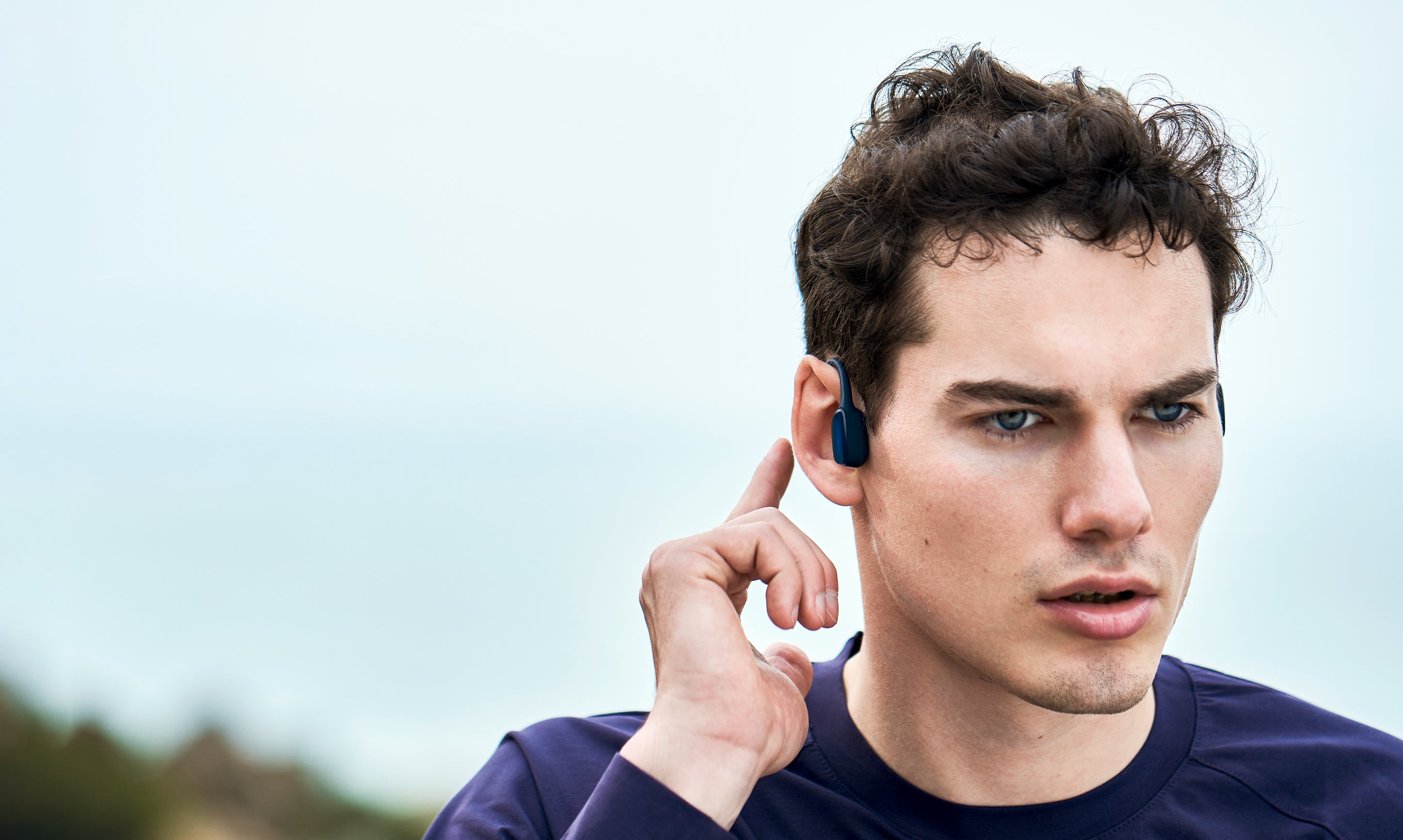Bone conduction headphones are a unique style of audio device that transmits sound through vibrations in your facial bone rather than directly into the ears. If you're considering your first pair or want to learn more about the technology, this guide tackles the 11 most frequently asked questions. We'll cover what bone conduction is, who it's ideal for, the pros and cons, and other vital details you should know before purchasing bone conduction headphones.

What Exactly Are Bone Conduction Headphones, and How Do They Work?
Unlike traditional headphones that sit inside or over your ears, bone conduction headphones deliver audio through contact pads that rest in front of your ears and transmit vibrations through your cheekbones to your inner ear. This enables you to listen to music and calls without having your ear canals blocked.
The contact pads on bone conduction headphones contain transducers that generate vibrations. These vibrations get transmitted into your facial bones, specifically, the cheekbones which connect to your cochlea. Your cochlea then converts those vibrations into sound signals that your brain perceives as audio, just like normal hearing. Essentially, bone conduction headphones enable hearing by sending audio signals through vibrations to your cochlea rather than directly into your ear canals.
1. Are Bone Conduction Headphones Really Worth the Investment?
For certain consumers and use cases, bone conduction headphones provide unique benefits not found in traditional headphones:
- Situational Awareness: With your ear canals open, you can clearly hear ambient noises around you for increased spatial awareness and safety. This makes bone conduction headphones ideal for activities like running or biking, where paying attention to your surroundings is crucial.
- Hearing Accessibility: Those with partial or total hearing loss can still perceive audio from bone conduction headphones since sound transmits through vibrations rather than the ear canal. This makes them especially beneficial for those with unilateral hearing loss or deafness in one ear.
- Communication: You can seamlessly hear conversations and announcements while listening to music or calls due to the open-ear design. This makes bone conduction headphones well suited for workplace use.
- Comfort: The lightweight build and lack of ear canal plugging results in reduced ear fatigue over extended listening sessions compared to in-ear models. Open ears also decrease sweat buildup.
2. Why Do You Get Sound Leakage With Bone Conduction Headphones?
While bone conduction headphones transmit audio via vibrations through your facial bones, some of these vibrations inevitably still get transmitted through the air as well. This results in minor sound "leakage" from the headphones - those nearby may be able to faintly hear what you're listening to.
The sound leakage stems from vibrations emitting from the contact pads on the cheeks that don't get fully transferred into the facial bones. Some of these vibrations end up dispersing through the air instead. The leakage is comparable to listening to low-volume music or podcasts from your smartphone speaker. Nearby listeners won't get blasted with your audio, but voices and details may be audible to those in close proximity in quiet settings.
If minimizing sound leakage is a major priority for you, look for bone conduction headphones engineered for a tighter fit to reduce airborne vibrations not transferred into the facial bones. Also, keep volume levels low, especially around others in compact areas.
3. Are Bone Conduction Headphones Safe for Outdoor Sports and Exercise?
Absolutely. Bone conduction headphones are actually ideally suited for activities like running, biking, and hiking due to their open ear design:
- You maintain complete spatial and situational awareness of your surroundings, able to fully hear approaching traffic, people, animals, etc. This enhances safety when exercising outdoors among potential hazards.
- Bone conduction headphones stay securely positioned during even intense physical activity thanks to the snug over-ear fit. You don't have to worry about loose wires bouncing around, either.
- Sweat and weather resistance ensures your headphones won't fail even when exposed to heavy rain or sweat.
- The lightweight build and lack of ear canal blocking results in dramatically reduced irritation and sweat buildup during prolonged use when exercising.
- Maintaining your natural hearing and situational awareness makes bone conduction headphones a very safe choice for outdoor fitness. Just take normal precautions, like watching your surroundings and avoiding distractions. The spatial awareness bone conduction headphones provide make them a wise choice for safe outdoor exercise.

4. How Does Ambient Noise Affect the Listening Experience With Bone Conduction Headphones?
Since external noises aren't sealed out, you'll perceive environmental sounds along with your audio. This makes it harder to pick out details and slightly reduces clarity. Strong winds generate substantial interference when biking. Nearby conversations, traffic noise, etc., can also intrude on your listening experience. To counteract noisy surroundings, you'll need to turn up the volume on bone conduction headphones higher than normal closed-back models.
5. Will Bone Conduction Headphones Work Properly If You Wear Glasses or Sunglasses?
For some bone conduction headphone models, wearing glasses - especially larger styles with thick frames - can negatively impact comfort and audio quality. To avoid these issues, seek out bone conduction headphones designed to readily work with eyeglasses. Models with adjustable or rotatable transducer arms that angle around your glasses frames tend to perform best. Frames with thin arms and wire sunglasses also usually play nicely with bone conduction headphones.
Even with glasses-friendly designs, expect to have to spend some time adjusting the fit and position to find the optimal sweet spot between comfort and audio quality when wearing your eyewear. But with the right pair, bone conduction headphones can work great with glasses or sunglasses.
6. How Long Do Bone Conduction Headphones Take to Charge, and What's the Battery Life?
Most bone conduction headphones deliver 4-8 hours of continuous use per full charge. This is comparable to traditional wireless headphones. Fully recharging the battery takes around 2-3 hours on average. However, if you're looking for a game-changer, consider Mojawa Run Plus. Unlike most models, the Mojawa Run Plus features an exceptional fast-charging capability. Just a 5-minute quick charge gives you an impressive 90 minutes of listening time. This is an invaluable feature for those who need a quick boost during extended listening sessions, setting the Mojawa Run Plus apart from the competition.
7. Do Bone Conduction Headphones Remain Comfortable During Long Listening Time?
Leaving your ear canals open does help reduce ear fatigue versus in-ear models during lengthy listening sessions. Those prone to discomfort from having ears plugged up find bone conduction headphones much gentler over many hours.
Try to test out the fit and comfort in person if possible. Check for any pressure points that could irritate with prolonged use. But for most users, bone conduction headphones deliver very good long-haul comfort and ergonomics if you get the right fit.
8. Is There Any Risk of Bone Conduction Headphones Damaging Your Hearing?
There is no risk if bone conduction headphones are utilized responsibly at moderate, safe volume levels. The bone conduction drivers create localized vibrations but do not direct potentially hazardous high sound levels right into the ears like traditional headphones sometimes do.
However, it is still possible to turn bone conduction headphones up to dangerously loud volumes that could damage hearing over time through sustained exposure. Be vigilant to avoid maxing out the volume - stick to moderate levels whenever feasible and take occasional breaks.
Parents should monitor the volume if children will use bone conducting headphones. Volume limiters or adult supervision helps ensure safe audio exposure for young developing ears.
As with any audio device, moderate listening levels whenever possible. But bone conduction headphones do not carry the same hearing health risks as traditional in-ear or over-ear models when used irresponsibly at dangerously high volumes.
9. Are Bone Conduction Headphones Waterproof?
Yes, some bone conduction headphones provide water and dust resistance rated at IP67 or higher. This means they are fully protected against dust and can withstand immersion in 1 meter of water for 30 minutes without damage. The IP67 rating ensures adequate water resistance to handle heavy sweat and running in the rain. This makes headphones with this rating ideal for intense workouts in any weather. Some high-end bone conduction headphone models achieve an IP68 rating, meaning they can be submerged deeper than 1 meter and are more fully waterproof. However, not all bone conduction headphones carry this level of waterproofing.

10. Who Are Bone Conduction Headphones Really Made For?
Here are the user groups who receive the greatest benefits from bone conduction headphone technology:
- Runners, cyclists, and others needing heightened situational awareness when listening on the go.
- People prone to ear discomfort and fatigue from traditional in-ear or over-ear headphones.
- Multitaskers wanting seamless audio blending with natural hearing.
- Workplace users needing to communicate easily while listening to music/calls.
- Safety-focused listeners prioritizing environmental awareness.
Ultimately, bone conduction headphones work very well for all users. But they uniquely cater to specific listening requirements and use cases where traditional headphones fall short.
Bottom Line
Now that you're familiar with the pros, cons, and best uses, you can make an informed decision if bone conduction technology suits your needs. For the right listeners, they provide an invaluable audio experience traditional headphones can't match! Assess your personal priorities and listening scenarios. If the open-ear concept appeals to your needs, bone conduction headphones are definitely worth trying.
Read More
- How IP68 Waterproof Headphones Enhance Your Aquatic Adventures– mojawa
- Unlocking the Potential of 32GB Internal Storage in Bone Conduction Headphones– mojawa
- Why Bone Conduction Headphones Are a Runner's Best Friend– mojawa
- Why Bone Conduction Headphones Are a Runner's Best Friend– mojawa
- Bone Headphones for Meditation: The New Way to Relax and Focus– mojawa





Leave a comment
This site is protected by reCAPTCHA and the Google Privacy Policy and Terms of Service apply.